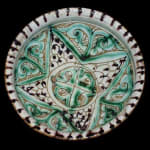Bamiyan Splashed 'Sgraffiato' Dish, 1100 CE - 1200 CE
Earthenware
JB.1283
Sgraffiato pottery belongs to one of the most important and earliest wares. It was believed that the technique was invented and introduced by the Copts in Egypt as early as...
Sgraffiato pottery belongs to one of the most important and earliest wares. It was believed that the technique was invented and introduced by the Copts in Egypt as early as the 4th and 5th centuries AD. Sgraffiato wares played an important role in Central Asian pottery during the 11th and 13th centuries. The technique involved incising the design into a ground slip and covered with a coloured or colourless transparent glaze.
This stunning bowl has a large central incised abstract foliate motif against a geometric scrollwork design. The dish is covered in a clear glaze. The designs and colour give the piece a very organic feel. The entire body is highlighted in green with additions of intermittent splashes of purple on the rim.
The incised wares of Central Asia have only emerged in fairly recent archaeological publications. They represent a very widespread and diverse manufacture. Significant quantities have survived in good condition, like the associated fritware.
This stunning bowl has a large central incised abstract foliate motif against a geometric scrollwork design. The dish is covered in a clear glaze. The designs and colour give the piece a very organic feel. The entire body is highlighted in green with additions of intermittent splashes of purple on the rim.
The incised wares of Central Asia have only emerged in fairly recent archaeological publications. They represent a very widespread and diverse manufacture. Significant quantities have survived in good condition, like the associated fritware.



